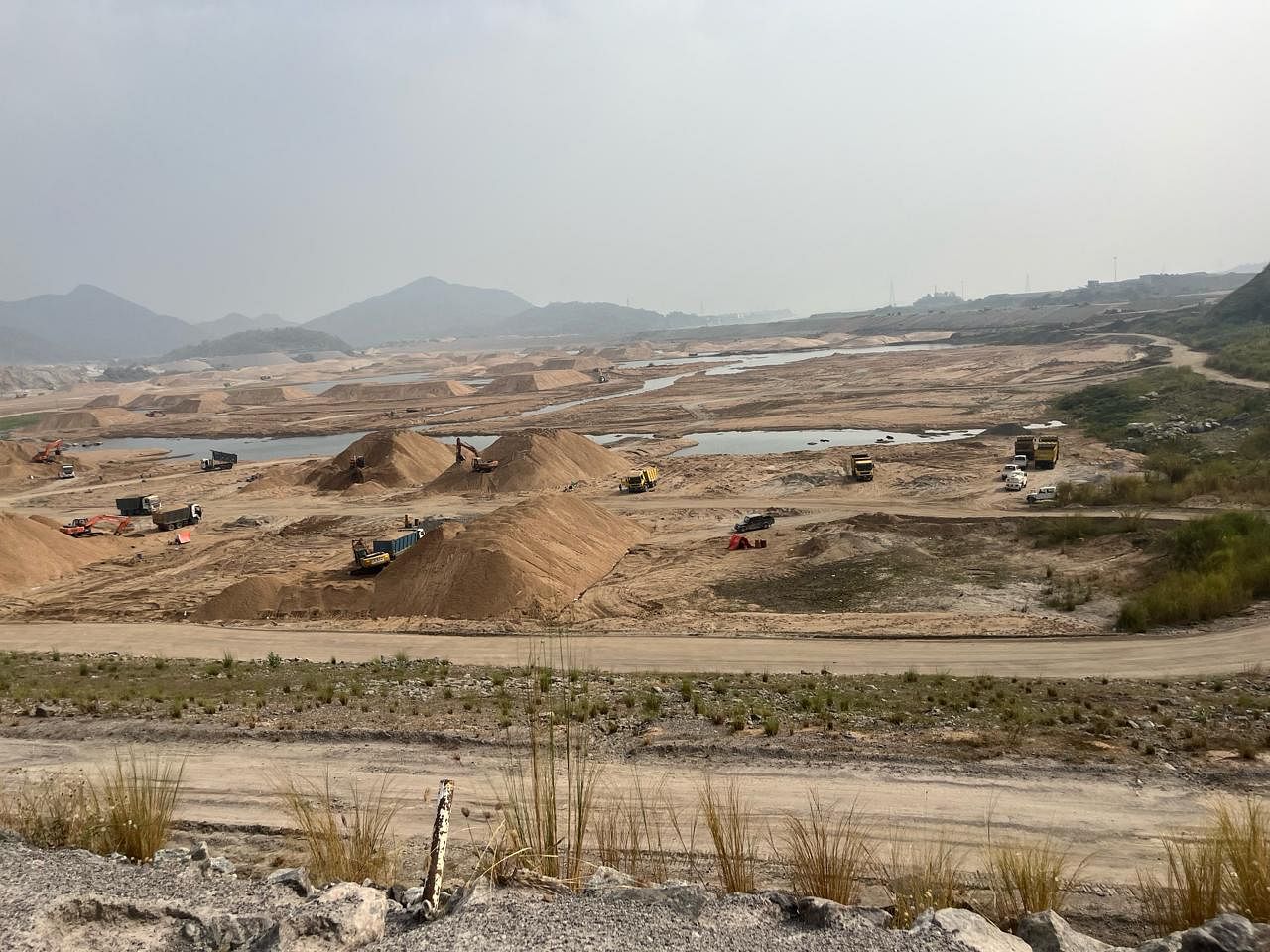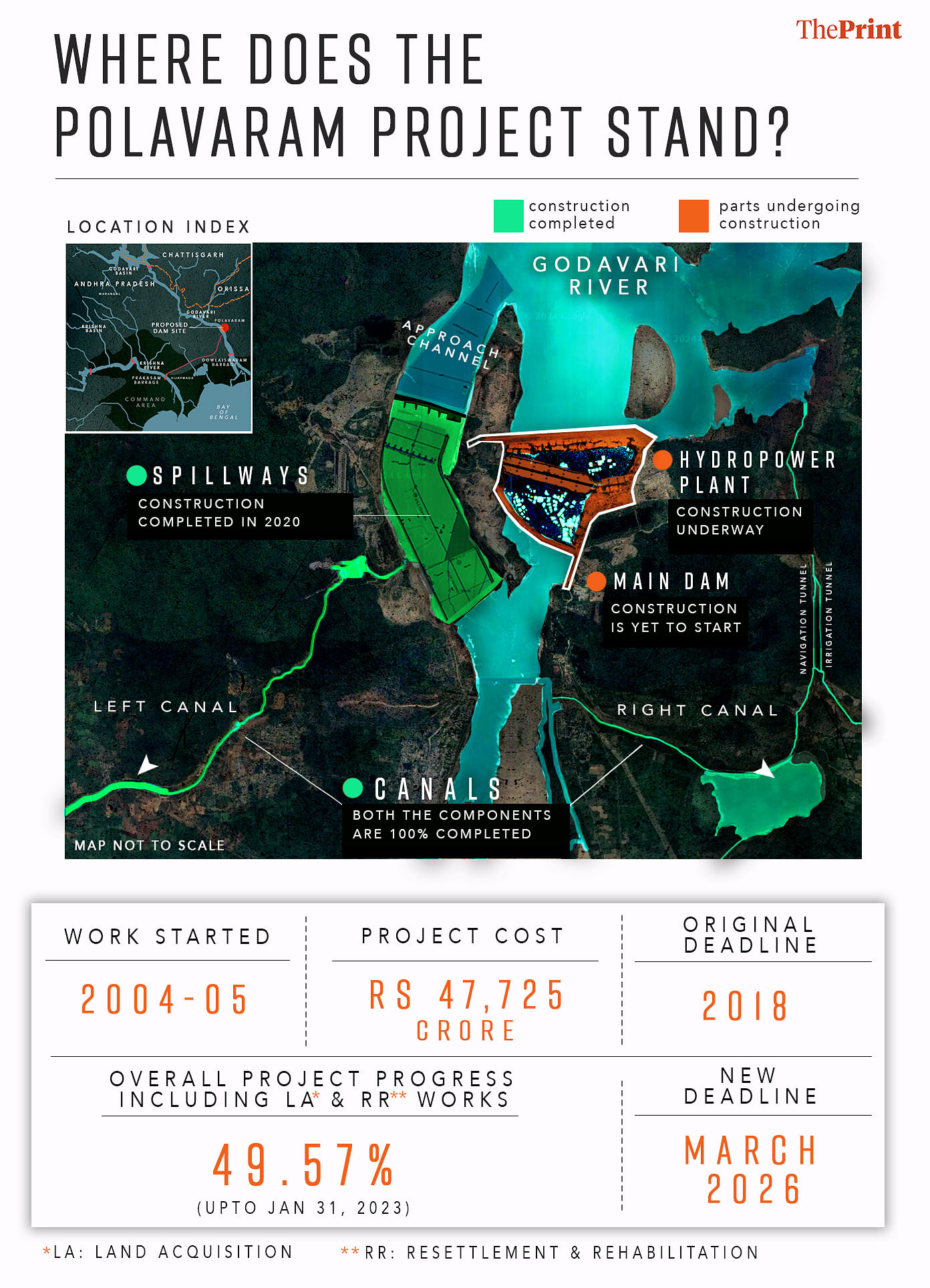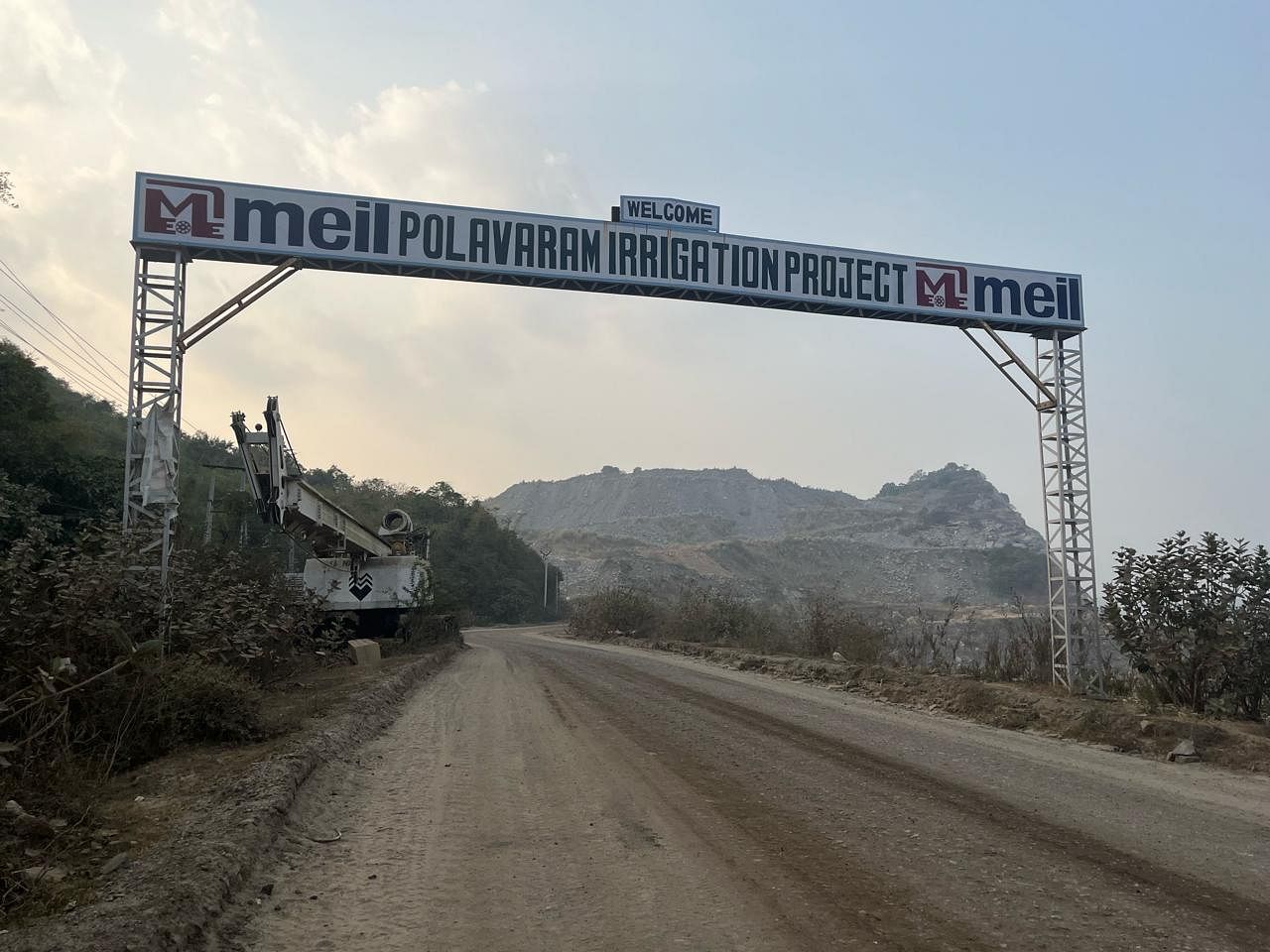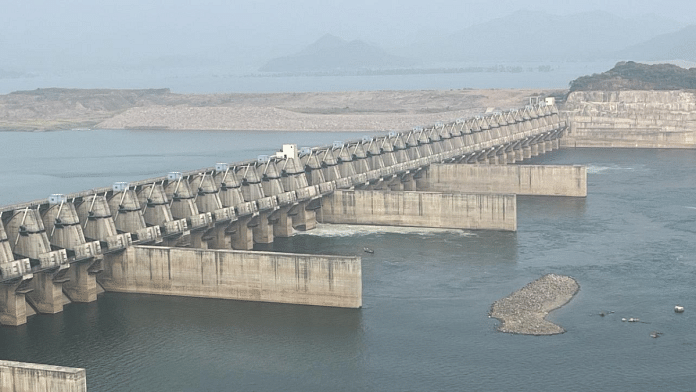Polavaram (Andhra Pradesh): About half a dozen sophisticated vibro-compact machines are humming along the stretch of the Godavari River where the Polavaram dam will eventually come up, to strengthen the riverbed’s foundation, on a hot February afternoon.
Godavari’s water has been diverted from this stretch by building two temporary cofferdams — one upstream and the other downstream — to enable construction. Cofferdams are temporary structures erected to divert the river water during the construction phase, after which they are dismantled.
Close to 150 workers — a minuscule of what a project of this magnitude requires — are moving around doing what in engineering lingo is called “ground improvement work” or basic foundational work. Had the pace of work been struck to its original timeline, the Rs 47,725 crore Polavaram multi-irrigation project would have been ready by 2018.
But the project, comprising an earth-cum-rock filled dam, two canals, and a 960 MW hydropower plant, has missed multiple deadlines since work first began in 2004-05.

Twenty years on and approximately Rs 21,000 crore later, the project is about half-way complete, senior officials of the Andhra Pradesh water resources department, which is getting the project implemented, told ThePrint. Though the financial progress of the construction work is 74 percent, the overall work — including land acquisition, and resettlement and rehabilitation — is just 49.57 percent complete.
And, construction on the main Polavaram dam, which will have a storage capacity of 194 TMC (thousand million cubic feet), has not even started. When ThePrint visited the dam site last week, only some basic foundation work was underway.
While the delays have pushed the project’s new deadline to March 2026, engineers from the state’s water resources department at the work site believe it could also miss that date. But they also hope that, ahead of the assembly and general election, due in April-May, the Centre may green-light the revised cost estimate of the project — hit by a severe cash crunch — proposed by the state.
Also Read: CAG calls Kaleshwaram project economically unviable — ‘every rupee spent would yield only 52 paise’
Floods, damaged structures, fund crunch — what has marred, progress
Technological challenges, financial crunch, poor planning, the dilemma over finalising the design, politics and contractors getting thrown out midway have meant that the Polavaram irrigation project continues to hang fire, depriving the state’s residents of its benefits.
The humongous delay since 2004-05 has resulted in some of the dam structures suffering major damages on account of floods in the Godavari in the intervening years. A senior engineer from the water resources department, who is working on the project, said that during the 2019 floods, half of the diaphragm wall — the core of the main dam built to restrict seepage from upstream to downstream — was washed away. It was built at a cost of Rs 442 crore.

Erecting a parallel diaphragm wall will cost approximately Rs 990 crore, a senior water resource department official told ThePrint. “A decision on whether to construct a parallel diaphragm wall or carry out repair of the existing structure is yet to be taken by the Central Water Commission. We have proposed erecting a parallel diaphragm wall as repairing the existing one could result in safety issues. We hope a decision is taken soon,” K. Narasimha Murthy, superintending engineer, Polavaram project, told ThePrint.
It’s only after the diaphragm wall has been constructed that work on the main dam can start.
Besides the diaphragm wall, floods in 2023 have also resulted in water seeping through the two cofferdams and inundating the riverbed where the dam has to be constructed. Last year, engineers had to install heavy-duty pumps to drain out the water from the riverbed at the construction site.
With pumps proving to be too time-consuming and costly, engineers did some out-of-the-box thinking and excavated a temporary channel to drain out the water downstream through gravity. Engineers now hope to drain out the water by next month from the expanse of the river bed, where the dam will come up.
“It’s very critically poised in terms of execution. The earlier mis-planning has delayed the project’s completion. Earlier, the project components were executed without any relevance to the SoPs of the major dams,” Narayana Reddy C., engineer-in-chief of Andhra Pradesh’s water resources department, told ThePrint.

According to Reddy, the project was previously executed haphazardly. The diaphragm wall was built in the main dam area without completing the cofferdam.
“Because of heavy flooding during 2019 and 2020, water gushed from the unfinished portions of the cofferdam and scoured the river bed to a depth of almost 36 meters, damaging the diaphragm wall also,” he said.
After the incumbent Yuvajana Sramika Rythu Congress Party (YSRCP) government came to power in 2019, the planning process for the entire project has been reassessed, Reddy said. “Now, the execution is on course and seepages that are occurring due to aging cofferdams are being addressed,” he said.
The Andhra Pradesh Water Resources Department has sent the proposal to restore/construct the damaged diaphragm wall to the Central Water Commission and Polavaram Project Authority.
“They have to decide on what option to choose — whether to repair the existing dam wall or go for a parallel diaphragm wall. A decision needs to be taken soon. Because we can’t build the dam till the diaphragm wall is ready,” Reddy said.
In the 20 years that the project has been in the making, so far the right main canal is 92.75 percent complete, the left main canal 72.81 percent. The spillways and their 48 gates were completed in 2020. The two cofferdams are also ready now.
Land acquisition, and rehabilitation and resettlement — the two key components of the project — are just 22.36 percent complete, a senior state government official told ThePrint.
Once complete, the Polavaram project will benefit all 26 districts of the state directly or indirectly and help irrigate 7.20 lakh acres of land, meet the drinking water needs of 28 lakh people, and also generate 960 MW of power from the hydropower plant that is coming up.
Fund crunch & politics
It’s not just the haphazard execution that has led to delay. A paucity of funds has also hit the project hard.
While work on the project started in 2004-05, it was only during the bifurcation of the undivided Andhra Pradesh in 2014 into two states — Telangana and Andhra Pradesh — that it was declared a national project. This meant that the state government would execute the project on behalf of the Centre and would get reimbursed for every penny spent by the state to complete it.
But the Centre and the Andhra Pradesh government have, over the last several years, locked horns over the actual cost of the project. While the Centre capped the project cost at the 2013-14 price level, which comes to Rs 29,027 crore, the state wanted the project cost to be approved based on the 2017-18 price level, which is Rs 47,725 crore.

After a lot of back and forth and several meetings between Prime Minister Narendra Modi and Andhra Pradesh CM Y.S. Jagan Mohan Reddy, a breakthrough seems to have been achieved.
“We are in 2023-24, almost a decade … So 2013-14 rates are highly impractical,” said Narayana Reddy C. to ThePrint. “On the request of our CM to the Prime Minister, broadly it is agreed that in the interest of the project, the more practical rates will be considered. The proposal is being considered. Shortly, the cabinet note will be finalised”.
There is a caveat though. According to the revised proposal, the Polavaram project is being executed in two phases.
In the first phase, the Centre will reimburse the cost required to complete the dam with the storage level of the reservoir up to a height of 41.15 metres as against the full reservoir level of 45.72 metres.
“At 41.15 metres, we can impound 120 TMC of water, which can be immediately used for irrigation and drinking and other purposes. The idea is to get the project operational to an extent that some revenue can be generated by reaping early intermediate benefits. Meanwhile, the work can go on in the second phase, where the reservoir level will be completed up to 45.72 metres,” Reddy said.
A storage level of 41.15 metres will require rehabilitation of 29,946 project displaced families (PDF) as against 93,000 PDFs if the storage level is 45.72 metres.
Engineers and officials involved with the project say that unless the central government takes quick decisions to sanction the state’s revised project costs, it’s highly unlikely that the project will be completed by 2026.
Politics over Polavaram
Polavaram project was first mooted in 1941 during the erstwhile Madras presidency. But because of technical difficulty in building the dam and the huge cost involved, it was put on the back burner. In 2004-05, the then CM of undivided Andhra Pradesh, Y.S. Rajasekhara Reddy took up the project — which was named Indira Sagar dam — under the Jalayagnam scheme.
Construction of the two canals was taken up first but work moved at a snail’s pace. In 2014, when Chandrababu Naidu became the CM, the project got new momentum. It was also rechristened as Polavaram.
In 2017, the old contractor, Transstroy, who was awarded the project in 2013 by the then Congress government led by Kiran Kumar Reddy, was removed, and the project was given to Navayuga Engineering.
The diaphragm wall was built during Naidu’s term, even though coffer dams were still incomplete.
In 2019, soon after Y.S. Jagan Mohan Reddy took charge as CM, he replaced Navayuga with Megha Engineering Limited.
When work began in 2005, the Polavaram project was estimated to cost Rs 10,151 crore according to the 2005-06 price level. The project has since missed multiple deadlines, with its cost increasing manifold.
Will the Polavaram project meet the March 2026 deadline? Engineers on the site are not making any guesses, but Reddy, the engineer-in-chief of the Andhra Pradesh water resources department, calls it “an intricate question”
“It is linked with so many issues. Even my minister has said that we are at it and we want it to happen early but still there are so many issues, financial as well as design related,” he said.
This is an updated version of the report
(Edited by Uttara Ramaswamy)
Also Read: Kishanganga to Bursar, why J&K dams aren’t just for development



